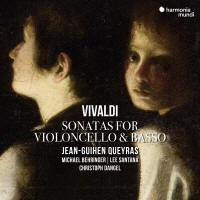Texte paru dans: / Appeared in: Harmonia Mundi |
|
|
Outil de traduction ~ (Très approximatif) |
|
|
Reviewer: Michael
De Sapio
A few issues back I
reviewed Jean-Guihen Queyras’s excellent recording of C. P. E. Bach cello
concertos with Ensemble Reonanz. The performances—played on modern
instruments but in a historically informed spirit—had passion, fire, poetry,
and intelligence. Here Queyras is back with another cornerstone of cello
repertoire, the six Vivaldi sonatas.
Like many musicians today,
Queyras has absorbed period style and can switch easily between period and
modern instruments. The liner notes don’t mention what kind of cello he is
playing here (according to Wikipedia, he plays an Italian instrument from
1696) but the pitch is A=415, and I would venture that the cello is in
period setup. That it is gut-strung and played with a Baroque bow there can
be no doubt. In other words, these are full-fledged period performances.
The interpretations are
relaxed, intimate, and low-key. Queyras isn’t one to overdo the adrenaline,
as some do when playing Vivaldi. As easeful as his delivery is, he can rough
up the melodic line when the music becomes more furioso, as in the fast
movements of the A-Minor Sonata No. 3. In slower movements, Queyras often
takes a rhapsodic and free approach to the melodic line.
Queyras varies the continuo
band with harpsichord or organ, cello, and theorbo. The choices are guided
by expressive considerations: The A-Minor Sonata No. 3, for example, has its
rhythmically forceful character brought out with the harpsichord and theorbo,
while the noble-sounding B♭Sonata No. 6 gets the organ treatment.
I should mention, since it is
not apparent from the headnote, that the order of the sonatas is scrambled
on this recording. Queyras believes that one should be free to shuffle the
cards since Vivaldi’s set is more a collection of pieces than an
architectural whole. This recording starts effectively with Sonata No. 5 in
E Minor, with its plaintive call at the beginning. The three sonatas in
B♭are then interspersed with the remaining two sonatas in A Minor and F
Major. The booklet includes an interview with Queyras, in which the French
cellist discusses his personal history with these pieces, the differences
between playing Bach and Vivaldi, and more. Queyras is certainly a cellist of taste and distinction, but what about other versions? Jaap Ter Linden’s (done with harpsichord and cello continuo throughout) is a good choice, and I also thought well of L’Arte dell’Arco’s Francesco Galligioni in my review in Fanfare 40.5. Both Galligioni and Queyras use a more varied continuo band, and both are excellent lyricists. But of the two, Galligioni’s group makes more compelling listening out of these sonatas, with more urgency in the line and imagination in fleshing out Vivaldi’s ideas. I would still not hesitate to recommend this release to Queyras’s fans. | |
|
|
|
|
|
|
|
Cliquez l'un ou l'autre
bouton pour découvrir bien d'autres critiques de CD |
|




